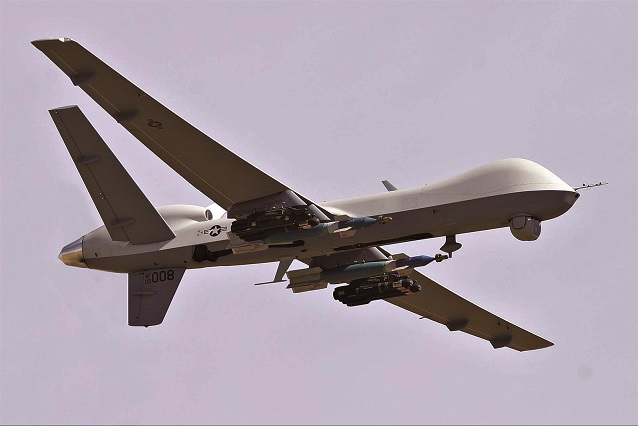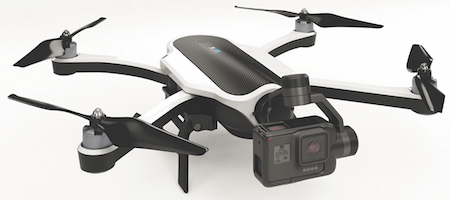House of Commons Briefing Paper October 2015
This note provides an introduction to the use of Remotely Piloted or Unmanned Aircraft by the UK Armed Forces. They are more commonly known as drones and have been described as the most contentious conventional weapons system currently in use.
Remotely piloted or unmanned aircraft range in size from simple, hand- operated systems to high altitude, long endurance systems similar in operation to manned aircraft. They allow ground troops to look over a hill to assess enemy positions or, by loitering over an area for many hours, provide commanders with persistent surveillance of enemy positions without putting service personnel at risk.
In Afghanistan (2007-2014) they were primarily used to support ground troops to provide intelligence, surveillance and reconnaissance. Only one of the five systems in the UK’s current inventory can be armed: Reaper carried out air strikes in Afghanistan and since 2014 in Iraq. Two British nationals were killed in Syria by a UK Reaper aircraft in 21 August 2015. The Prime Minister said this was the first time in modern times that a British asset has been used to conduct a strike in a country where the
UK is not involved in a war. 2014 also saw the first deployment of a
remotely piloted aircraft on maritime operations.
The forthcoming Strategic Defence and Security Review should provide some clarity on how the Government envisages how remotely piloted air systems will fit into its future force plans. The UK is already actively seeking a replacement for Reaper from 2018 and the Prime Minister announced in early October 2015 plans to replace the existing fleet of
10 Reapers with more than 20 new RPAS. The Ministry of Defence is also considering whether a remotely piloted aircraft could fulfil its maritime surveillance needs. Further ahead, the Government is jointly funding with France a study into the feasibility of an unmanned combat aircraft as a possible replacement for Typhoon from 2030.
Why are they contentious? Their use by the United States to conduct
‘targeted killings’ in Pakistan, Yemen and elsewhere has raised awareness about this relatively new technology and prompted questions about the legality, utility and morality of these systems. These questions, which are explored in this note, include: do airstrikes from remotely piloted aircraft comply with international law? Does having the
capability lower the threshold to use force? Does it turn warfare into a
‘video game’ with operators firing missiles by remote control? How is information gathered by UK aircraft shared and used by our allies? How much of the system is automated and how much is controlled by a human? Could an armed capability be developed that could operate autonomously? The latter question has prompted a global campaign to pre-emptively ban the development of ‘killer robots’.
The UK Government position is that remotely piloted aircraft operate under the same rules of engagement as manned aircraft. The Government emphasises the primary role of these machines is to provide an intelligence, surveillance and reconnaissance (ISR) capability. It states that all air strikes are conducted in accordance with International Humanitarian Law (the Law of Armed Conflict). The Government says it has no plans to develop fully autonomous systems and that all present and future systems will remain under human control.

Remotely Piloted Aircraft Systems: What are they?
Remotely Piloted Aircraft, commonly referred to as drones, are aircraft that do not carry a human operator and are flown remotely by a pilot. They range from simple hand-operated short-range systems to long endurance, medium altitude systems.
The UK military primarily uses them for Intelligence, Surveillance and Reconnaissance (ISR) or Intelligence, Surveillance, Target Acquisition and Reconnaissance (ISTAR). The UK also uses Reaper to conduct air strikes.
Terminology
The terminology relating to these systems has evolved over time. They are commonly known as drones in the media and public.
The Ministry of Defence has switched from using Unmanned Aerial Vehicle/Unmanned Aerial System to Remotely Piloted Aircraft/Remotely Piloted Aircraft System. This is because it felt the term unmanned could be unhelpful because it may have caused confusion over the level of human control over the aircraft. The Ministry of Defence has provided the following definitions:
A Remotely Piloted Aircraft is defined as an aircraft that, whilst it does carry a human operator, is flown remotely by a pilot, is normally recoverable, and can carry a lethal or non-lethal payload.
A Remotely Piloted Aircraft System is the sum of the components required to deliver the overall capability and includes the pilot, sensor operators (if applicable), the aircraft, a ground control station, associated manpower and support systems, satellite communication links and data links.
An Unmanned Aircraft (sometimes abbreviated to UA) is defined as an aircraft that does not carry a human operator.
An Unmanned Aircraft System (UAS) is defined as a system, whose components include the unmanned aircraft and all equipment, network and personnel necessary to control the unmanned aircraft.
The Defence Committee noted that it may be more appropriate to use unmanned air systems to describe the systems used by the Army for ISR.
What are they used for?
The RPAS and UAS used by the UK Armed Forces are primarily used to provide ISR or ISTAR: Intelligence, Surveillance, (Target Acquisition) and Reconnaissance. Of the five types of systems used by the Armed Forces, only one fulfils an additional role: strike. Reaper is the only system that can be armed and conduct air strikes using missiles and bombs. It is also used to provide ISR or ISTAR. Section 2 of this note lists all the remotely piloted and unmanned systems currently in use, section 3 looks ahead
to future capabilities and section 4 examines how and where they have been used.
Strengths
The advantages of RPAS over manned aircraft include:
• Good for ‘dull, dangerous and dirty’ tasks
• Provide a persistent presence over a specific area providing still and video imagery
• Provide an intelligence, surveillance and reconnaissance capability for ground troops. For example: An ‘over the hill’ visual aid for infantry soldiers. A persistent presence in the air to identify enemy movements e.g. placing an IED
• Reduces the manpower footprint in theatre
• Provides an additional air strike capability (Reaper only)
• Can be relatively cheap.

Weaknesses
They also have plenty of weaknesses:
• Have relatively low maneuverability, operate and low speed and have no or little defensive measures
• Vulnerable to attack from a sophisticated air defence network
• Currently limited to operating in a permissive or segregated airspace
• Vulnerable to cyber and communications link attack or lost data links
• The more advanced systems may require as heavy if not heavier crew requirement than manned aircraft
• May not be cost effective: “If current trends continue, it is likely that the cost of complex unmanned aircraft will increase to converge rapidly with those of manned aircraft”
• Vast quantity of data collected requires sophisticated data analysis to enable the data is analysed and distributed.
How many are there?
The UK operates five different types remotely piloted aircraft systems. Latest figures available are:
-
10 Reaper (as of June 2015);
-
29 Watchkeeper (8 aircraft in the forward fleet and 21 in storage as of 26
March 2015);
-
222 Desert Hawk III, and
-
324 Black Hornet (as of 1 April 2013).
The numbers for the latter three systems are the latest available but should not be relied upon as reflecting the current fleet.
Worldwide it is estimated there are only a handful of medium-altitude, long-endurance RPAS types in the world and some states that have Reaper, like Italy, do not arm them. Ulrike Esther Franke estimates the total number of MALE remotely piloted aircraft in use around the world to be about a thousand, and that includes the largely unknown number of MALE UAVs in Israeli, Chinese and Iranian military arsenals. By contrast, she says, there are tens of thousands of smaller, tactical drones (sometimes called mini or micro UAVs).


.jpg)
.jpg)
.jpg)

.jpg)




